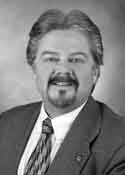 | Robb Rose is Director of Marketing Operations at Wesley Rehabilitation Hospital of Wichita. Robb is also a Respiratory Therapist, Boarded Disability Analyst and Adjunct Faculty for Wichita Sate University. He holds a Masters in Human Resources from Webster University. Robb serves on the American Lung Association Regional Council and the American Heart Association Board of Directors. Robb is married and has 2 children. He can be reached at (316) 729-9999 |
Health & Rehabilitation
2009-08-01 12:16:00
Rehab therapy
Question: What is an inpatient rehab facility and why are some of the nursing homes I see advertising rehab therapy?
Answer: The primary difference has to do with federal guidelines and accreditation as an inpatient rehab facility (IRF). A true inpatient rehab facility has made the commitment to meet rigorous federal standards, and additionally pursues accreditation as an IRF.
An IRF must perform a combination of at least two therapies per day for a minimum of three hours for at least five out of seven days. That minimum of two therapies must be a combination of physical therapy, occupational therapy and speech therapy. Other therapies which involve audiology (such as vestibular balance programs), recreational therapy and others do not count in the minimum standards, but are offered additionally.
An accredited IRF must have a physiatrist (a physician who specializes in physical medicine) orchestrating the care of the patient daily. A skilled nursing facility and care home will have a physician visiting patients as few as one to two times a week.. A quality IRF will have a Fellowship Trained Clinical Neuropsychologist on staff to conduct specialized diagnosis and treatment for head and brain injury patients, to include stroke and neurology based conditions. An IRF patient receives 24 hour, seven-days-a-week rehab nursing care with combined therapies for three hours per day. An individualized plan of care is based on the patient’s diagnosis and needs, and includes a reasonable discharge goal of back to the patient’s home with appropriate support.
Inpatient Rehab is a multidisciplinary team approach. An IRF’s focus on stroke, neurology, amputations, spinal cord, brain injury, rheumatoid arthritis, congenital deformities, vascularities, hip fractures, multiple joint replacements and severe osteoarthritis, are all defined by national standards.
A consumer of inpatient rehab care will want to ask:
1)Is this inpatient rehab facility part of a nationally accredited Stroke/Neuro Center of Excellence through The Joint Commission? This means it provides a true continuum of care at a high level, based on the highest national standards for this type of complex patient.
2)Is this IRF dual-accredited? Does it meet both the basic standards for accreditation and have a specialized focus specific to rehab? For example, an IRF having accreditation from The Joint Commission plus accreditation from the Commission on Accreditation of Rehabilitation Facilities, specific to rehab, shows a real commitment to rehab high standards.
3)Does this IRF not only have a physiatrist, but also a full-time, on-campus medical intensivist to provide medical management of all medical issues? Such a facility has a physician that is an Internal Medicine specialist on campus full time to care for patients, while the physiatrist orchestrates the overall rehab issues.
4)Is there a good balance of new rehab technology plus qualified people? New technology is important to stay up-to-date with leading-edge proven therapies, but rehab is about people working and caring for people. Bonding, trust and caring are key to a patient’s successful outcomes.
5)Does this IRF have a true Community Reintegration Program? Community reintegration has to do with shopping, driving, going out to eat, going to a movie, banking, gardening, playing video games — the activities of daily living. Look for a facility that has these functions to practice on the IRF campus. Many specialized facilities have these types of reintegration programs, with names such as “Easy Street.” Patients and their families can practice in the facility’s in-house theatres, grocery stores, banks and actual automobiles; even video games such as WI Therapy can assist with achieving the rehab goals for each patient.
6)Does this IRF have spiritual, musical, and psycho-social support? An on-site chapel with chaplains and the opportunity to openly pray and/or attend religious/spiritual programs, attend professional music therapy programs and have access daily to psycho-social support such as a clinical psychologist and support groups are very important.
7)What access do they provide to specialty care on site, such as dialysis, or an accredited sleep center for sleep apnea diagnosis, treatment and education? I hope this helps answer your question so you know what a properly accredited inpatient rehab facility (IRF) is, and can differentiate one from other places advertising rehab therapy.


